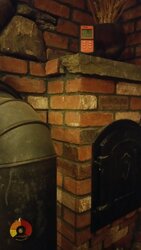New to the forum and I have a question that I can't seem to find the info around the internet.
In an attempt to increase the efficiency as much as possible with my Quadra Fire stove and reading the forums everyone suggests starting with a flue thermometer. I purchased a Condar- 4" Flue Guard thermometer. Mounted it 18" above the stove (back in November) and now understand that my burning temps are in the safe range 400-900 degrees (average is around 500 degrees).
Stove info:
Quadra Fire
Isle Royale
007 1028048
Manufactured Feb 2007
Everything I read said that if I do this Ill be fine. Out of curiosity I wanted to know what the flue gas temp was leaving the flue, so I purchased a "Thermo Pro- Remote Food Probe" (cool little device!) and monitored the temps from the top of the chimney for several nights. I mounted it in the center of the flue about 10" down from the top of the chimney flue using steel rebar as a support.
Here's the Question:
Condar reads 900 degrees / remote sensor (chimney top) reads 190 degrees
Condar reads 500 degrees / remote sensor (chimney top) reads 140 degrees
Should I be concerned about creosote build up, as it is FAR below the 250 degree (safe) threshold?
Here are a few better photos from "Google Photos" of the house lay out and chimney set up in the rear of the house.
https://goo.gl/photos/STvVAEJjBXHab4Fu7
As a side note while I was up there with the ladder I swept the chimney. I did notice heavy buildup (3/16") of creosote/ ash in the 6" metal flue above the stove and not a tremendous amount in the masonry flue. I clean the chimney every April (we burn about 6.5 cord) and I'm sure that I didn't clean the 6" metal flue last year, don't recall the reason??
Is it possible that the draft was effected.
Last night after cleaning, the wood stove ran like a champ! I had already removed the remote sensor and so I don't have more data for last nights burn, I could set it back up again if need be.
Thanks for your help.
Cheers!

In an attempt to increase the efficiency as much as possible with my Quadra Fire stove and reading the forums everyone suggests starting with a flue thermometer. I purchased a Condar- 4" Flue Guard thermometer. Mounted it 18" above the stove (back in November) and now understand that my burning temps are in the safe range 400-900 degrees (average is around 500 degrees).
Stove info:
Quadra Fire
Isle Royale
007 1028048
Manufactured Feb 2007
Everything I read said that if I do this Ill be fine. Out of curiosity I wanted to know what the flue gas temp was leaving the flue, so I purchased a "Thermo Pro- Remote Food Probe" (cool little device!) and monitored the temps from the top of the chimney for several nights. I mounted it in the center of the flue about 10" down from the top of the chimney flue using steel rebar as a support.
Here's the Question:
Condar reads 900 degrees / remote sensor (chimney top) reads 190 degrees
Condar reads 500 degrees / remote sensor (chimney top) reads 140 degrees
Should I be concerned about creosote build up, as it is FAR below the 250 degree (safe) threshold?
Here are a few better photos from "Google Photos" of the house lay out and chimney set up in the rear of the house.
https://goo.gl/photos/STvVAEJjBXHab4Fu7
As a side note while I was up there with the ladder I swept the chimney. I did notice heavy buildup (3/16") of creosote/ ash in the 6" metal flue above the stove and not a tremendous amount in the masonry flue. I clean the chimney every April (we burn about 6.5 cord) and I'm sure that I didn't clean the 6" metal flue last year, don't recall the reason??
Is it possible that the draft was effected.
Last night after cleaning, the wood stove ran like a champ! I had already removed the remote sensor and so I don't have more data for last nights burn, I could set it back up again if need be.
Thanks for your help.
Cheers!


